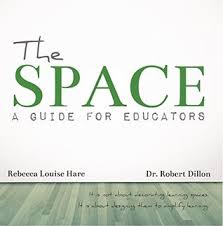“Your students deserve classrooms that support their learning experiences. You can design that space.” Hare and Dillon
If I were able to start a school from scratch, it would look very different to those traditional classrooms we mostly still have today. There would be considerable flexibility: in furniture, space and teaching. Seating would be a range of options from coffee to standing tables. There would be sofas, bean bags and pillows for those wanting an alternative to sitting at a table. The space itself would have several ‘zones’. The function of these zones could be determined in collaboration with your cohort of students. Examples could include a quieter zone, a reading zone, an imagination zone, a maths zone or a science zone. Lighting would also be different for the various zones as well. Teaching would no longer be someone standing at the front giving all the information to be rote learned for constant testing.
Interestingly, this dream is starting to become reality. There are some school who are bravely taking a step in this direction. Gone are the days of classrooms. Instead they are now referred to as ‘studios’. Work has been replaced with ‘learning’ which is encouraging continuous effort that is enjoyable not a labour. Teaching also is changing. Some schools are opting for team teaching where there are two studio teachers and an assistant for each grade level. Yes, the class sizes might be a little larger but there are three educators assisting students with their learning. How wonderful to have another educator teaching alongside you who helps you to co-plan, co-teach and co-assess! Imagine having a second option on how to reach a particular student, a second option in the form of another teacher who ‘knows’ that student as well as you!
With change there are always challenges. It can take staff six to twelve months to adjust to working within these new conditions. Let’s consider the changes that can be overwhelming at first. There may not be one physical seat for every student; teaching may not occur as a whole class but as small group workshops; students may take more ownership of their own learning thereby building self-regulatory skills; learning might have more of an inquiry focus; and teaching personalities and styles my take some time to find their working balance.
There are also many beneficial changes that can transpire that should be noted. Think of a ‘studio’ where learning is amplified; students are more motivated and engaged and they feel empowered; overall focus and attention is significantly higher; teachers are more like coaches who guide, instruct and prepare their students; and the process of learning is valued higher than the end products. If students can take ownership of their learning through choice of content and where they actually undertake their learning, the benefits can be astounding.
While these changes might seem to some like science fiction and a fearful next step, in fact I am seeing the extraordinary benefits. Yes, I have the pleasure of working in such a transformative school. Our school was redesigned with the 21st century learner in mind. We are now in our fifth year of learning studios and I don’t think I would ever go back to my old classroom where I did everything on my own. I now work in an extremely collaborative environment where students are exceeding expectations. I am living the dream in a very exciting learning environment.
Back to the reflection question: If you were to start a school from scratch, what would it look like?
Curiously, I recently bought a book at an EdTechTeam conference in Melbourne and that would exceptionally valuable if you starting the journey of redesigning your school. “The Space: A guide for educators” by Rebecca Louise Hare and Dr Robert Dillion is an amazing resource. It is both instructive and is a guided notebook for you to jot your ideas down. It provides the right amount of thoughtful provocation and advice for moving forward. It will inspire you to rethink what a school/classroom should look like or be. I recommend this book to anyone thinking of making a step towards a learning space that empowers students!
“Your students deserve classrooms that support their learning experiences. You can design that space.” Surely this is what we want for our students! Let’s be brave and take the first step towards this goal.
